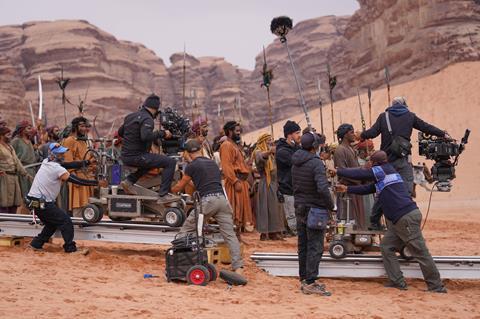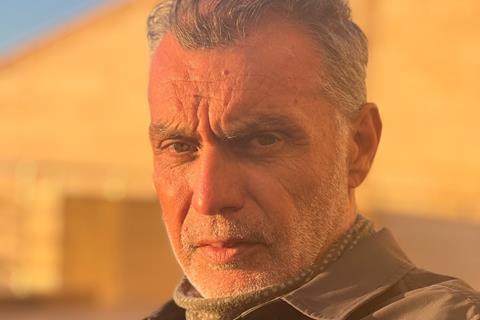Eric Hedayat — the US executive producer of the $150m Desert Warrior — talks to Screen about shooting the first tentpole feature on location at Neom’s desert facility Bajdah

“The aim was to make a Saudi story but to make it international, with international talent,” says executive producer Eric Hedayat of Rupert Wyatt’s Desert Warrior.
“MBC Studios was adamant it wanted to shoot in Saudi,” Hedayat explains about the $150m historical epic produced by Jeremy Bolt at JB Pictures in partnership with Saudi media conglomerate MBC Studios. “Our original plan involved shooting in Dubai, then a few locations in Saudi, like Jeddah Old Town, and the area of Neom. But because of Covid, and other factors, I contracted the whole project to stay on the Neom property.”
This was in late-2020, when Neom’s production facilities Media Village and Bajdah in northwest Saudi Arabia were just getting up and running. “We were doing a story set in the desert and there are a lot of beautiful deserts in Saudi. The problem is a lot of it is four hours from the nearest hotel,” recalls Hedayat, an experienced producer and production manager who has worked all over the world.
In Tabuk, he not only found a hotel — the Grand Millennium — big enough for cast and crew but which was also within a 45-minute drive of Bajdah, the desert region that provided vast, untouched and hitherto unfilmed vistas. “Bajdah is remarkable. You can find a desert that’s rocky or has red sand or is light coloured or is flat, like a salt flat. So we set the film up at Bajdah, then spanned out into the Neom region.”
Test case

As the first major feature to shoot at Neom, Desert Warrior was, to many, a test of the region’s capability for mounting such an ambitious project. “There were several fronts where, frankly, we couldn’t have done it without Neom’s assistance,” Hedayat says. “Neom would help us anytime we got in trouble in terms of visas or helping organise the housing issues or access to certain locations. It was hundreds of crew, thousands of extras, horses, camels, chasing and fighting in the desert.”
The production received financial support through Saudi’s national 40% cash rebate, which Neom enhanced with additional support.
Crew came from more than 100 countries. Equipment was sourced mostly from the UK and US as well as from regional centres such as Dubai and Jordan. “Wardrobe, because it was period, we made a lot ourselves, but brought quite a bit out of Spain,” says Hedayat. “Neom is now building up vendors [including] some of the guys in our project, like our special-effects guy — I brought him out of Dubai, he is originally from London but now has an office at Neom and equipment there. Same with our construction guy — he is from Lebanon, and had a setup in Riyadh, but is now at Neom.”
After prepping in late-2020, production shut down for four months because of Covid, before picking up again in June 2021, and then shooting for 81 days from September through to Christmas.
“We never lost a day of production, for any reason,” says Hedayat, who was able to “institute, effectively, a Hollywood system” for the production, which returned to Neom in February 2023 for brief reshoots.
Accessing the desert was a challenge but Hedayat says Neom’s location manager Tobin Hughes was “available to us all the time” and helped get track systems to go out in the desert. “That was a whole other challenge, getting all the vehicles we needed, which Neom didn’t have but was helpful in sourcing anything we needed.”
The result was “an insane number of pick-up trucks and all the crew would drive to the set”, Hedayat adds. “In the US, we would use five- and 10-ton trucks and 40-footers, go out to the location and break out the gear. What we did here was put all the gear in four-wheel-drive pick‑ups. We also had a dune crawler and four-to-six-wheel oversized trucks we could load heavy equipment into that wouldn’t get stuck. In some places we walked the horses and camels out for two hours before call, because you couldn’t put them in trailers, they would sink.”
Hedayat is keen to return. “It was great to see how many people have called me since, [saying] ‘I want to go back to Saudi, do you have another project?’ It’s a very different kind of lifestyle to the one we are accustomed to in the [US] industry.
“Neom is a unique place, landscape wise, and it is supporting in a great way.”























No comments yet